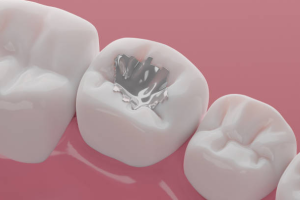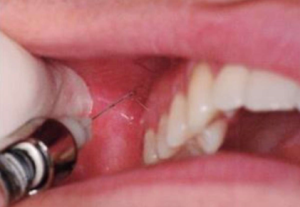
Amalgam fillings, commonly known as silver amalgam or silver fillings, are one of the oldest dental filling materials and have been a staple in restorative dentistry for centuries. Despite the emergence of newer materials, such as glass ionomer fillings and resin fillings, amalgam remains widely used due to its durability and cost-effectiveness. This article will explore what silver amalgam is, its benefits and drawbacks, and the steps in the procedures for receiving a silver filling.
What is an Amalgam Filling?
Silver amalgam, the primary material that makes up amalgam fillings, is a dental restorative material composed of a mixture of mercury and an alloy of silver, tin, copper, and sometimes zinc. The process of combining these materials is known as amalgamation. Each metal has a unique purpose, which helps make silver fillings a strong material:
- Mercury (Hg): Acts as a binder for the alloy particles.
- Silver (Ag): Provides strength and durability.
- Tin (Sn): Contributes to the workability and strength.
- Copper (Cu): Enhances strength and reduces corrosion.
- Zinc (Zn): Acts as a scavenger during the alloying process.
Benefits of Amalgam Fillings
Silver amalgam offers several advantages, including:
- High Mechanical Properties: Studies, such as those by Chadwick et al. (2002), have shown that silver amalgam fillings have superior longevity compared to resin composite fillings and glass ionomer fillings, often lasting over a decade with proper care.
- Easily Packable: The packability of amalgam fillings helps ensure proper contact with healthy tooth structure. This helps prevent cavities from forming under these fillings, which are known as secondary carries or recurrent carries.
- Carvable: After placement of this filling, it can be shaped to match the tooth’s anatomy due to its carveable nature.
- Self-Sealing Properties: Over time, amalgam has self-sealing properties, contributing to its excellent longevity in clinical use.
Disadvantages of Amalgam Fillings
Despite its benefits, silver amalgam has some drawbacks:
- Aesthetic Concerns: The silver metallic colour is not tooth-coloured, making it less aesthetically pleasing.
- Brittleness: These fillings have low tensile strength and can be brittle in thin sections. This means that dentists may be forced to remove more healthy tooth structures than necessary to ensure the fillings last a long time.
- Mercury Content: Raises concerns about potential health and environmental impacts. Generally, silver fillings are very safe for use on patients.
What to Expect During a Cavity Filling Procedure
The average time for one filling can range between 30-45 minutes, but additional teeth or cavities in between can take longer depending on size and clinician experience. The steps in the filling procedure generally follow this pattern:
During the Procedure
Local Anesthesia Administration:

During a filling procedure, a patient will first receive local anesthesia in the form of a numbing gel, followed by an injection. This will make sure that they do not feel anything during the procedure.
Removal of Decay:

Following this, the decay will be removed with a high-speed handpiece, which may make noise and involve water and air.
Rubber Dam Placement:

A rubber dam will be placed around the affected tooth to keep it dry and free from saliva during the procedure. Alternatively, a dentist could use cotton rolls to keep the tooth dry.
Amalgam Preparation:

The amalgam material is prepared by mixing the alloy with mercury in a machine called an amalgamator. This machine is extremely loud and vibrates the silver filling material quickly.
Amalgam Insertion:

The mixed amalgam is then carried to the cavity using a special tool and placed into the prepared cavity.
Amalgam Condensation:

The amalgam is packed tightly into the cavity using a condenser. This step ensures that there are no voids and that the material is well-adapted to the cavity walls.
Amalgam Carving and Burnishing:

The dentist will shape the amalgam to match the natural shape of your tooth. This step involves removing any excess material and defining the tooth’s anatomy. After carving, light burnishing will be done to further smooth the surface and enhance the filling’s shape.
Final Evaluation:

The dentist will check for any voids or gaps between the tooth and the filling, ensuring that the restoration has a proper shape and fit.
Final Bite Check:

The rubber dam is removed, and the dentist will check your bite again to make sure the filling does not interfere with your natural bite.
Recovery and Aftercare
If the filling is taken care of properly, it can last many years. The average time a filling lasts depends on the material used – amalgam fillings can last up to 10 years. After receiving a filling, make sure to:
- Brush and floss twice daily
- Schedule regular professional cleanings and exams
- Cut back on sugary snacks and drinks
- Use a fluoride mouthwash
- Wear a nightguard if you have bruxism (teeth grinding)
- Avoid hard, crunchy and sticky foods
- Quit smoking if you are a smoker
Conclusion
Silver amalgam remains a viable option for dental restorations due to its durability, ease of use, and cost-effectiveness. Understanding its composition, benefits, and procedural steps ensures optimal results for both dental professionals and patients. Despite some aesthetic and environmental concerns, amalgam’s longevity and mechanical properties make it a valuable material in restorative dentistry.
Disclaimer
The contents of this website, such as text, graphics, images, and other material are for informational purposes only and are not intended to be substituted for professional medical advice, diagnosis, or treatment. Nothing on this website constitutes the practice of medicine, law or any other regulated profession.
No two mouths are the same, and each oral situation is unique. As such, it isn’t possible to give comprehensive advice or diagnose oral conditions based on articles alone. The best way to ensure you’re getting the best dental care possible is to visit a dentist in person for an examination and consultation.
SAVE TIME AND MONEY AT ANY DENTIST

Less dental work is healthier for you. Learn what you can do to minimize the cost of dental procedures and avoid the dentist altogether!

